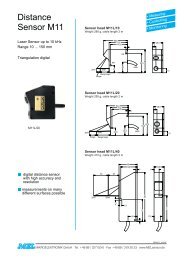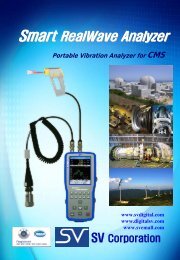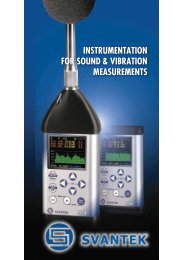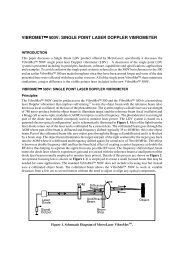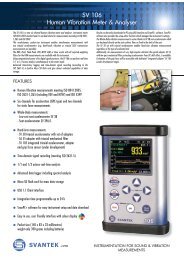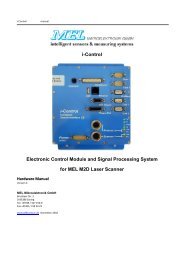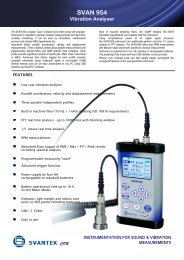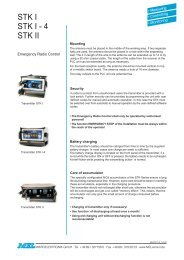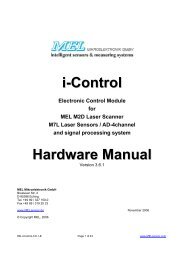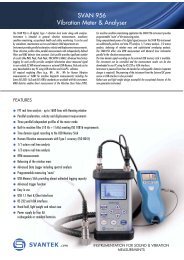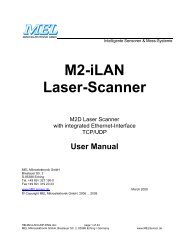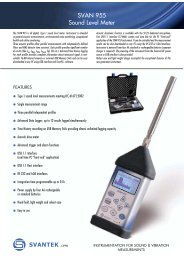2012 e-catalog - STIL
2012 e-catalog - STIL
2012 e-catalog - STIL
You also want an ePaper? Increase the reach of your titles
YUMPU automatically turns print PDFs into web optimized ePapers that Google loves.
SELECTION<br />
GUIDE<br />
SENSORS 3D SYSTEMS<br />
SPECTRO<br />
COLORIMETERS<br />
GONIO<br />
PHOTOMETERS<br />
Non-contact «point» sensors<br />
Classical optical pens (OP Line)<br />
OP Line<br />
Model OP300VM OP6000 OP8000 OP10000 OP24000 OP42000<br />
Measuring range (1) [µm] 300 6 000 8000 10 000 24 000 42 000<br />
Working distance (2) [mm] 5 28.8 37.2 66.9 223 518<br />
Max object slope (3) [deg] +/- 25° +/- 22° +/- 16° +/- 12° +/- 5° +/- 2.5°<br />
Reference plate (4) - No No Yes Yes Yes No<br />
Axial model (5)<br />
Radial model (5) -<br />
Standard<br />
Optonal<br />
Standard<br />
No<br />
Standard<br />
No<br />
Standard<br />
Optonal<br />
Standard<br />
Optonal<br />
Standard<br />
No<br />
LATERAL (XY) PROPERTIES<br />
Spot size (diameter)<br />
Lateral resoluton (6)<br />
[µm]<br />
[µm]<br />
8<br />
4<br />
12.5<br />
6.25<br />
34<br />
17<br />
51<br />
25.5<br />
100<br />
50<br />
110<br />
55<br />
MECHANICAL INTERFACE<br />
Length (8)<br />
Diameter (8)<br />
Weight<br />
[mm]<br />
[mm]<br />
[g]<br />
127<br />
15<br />
25<br />
205.5<br />
60<br />
727<br />
150<br />
40<br />
400<br />
189<br />
50<br />
640<br />
172.5<br />
59<br />
360<br />
287.2<br />
85<br />
1700<br />
Performances (9)<br />
DISTANCE MEASUREMENT<br />
Axial resoluton (10)<br />
Accuracy (11)<br />
[nm]<br />
[nm]<br />
10<br />
90<br />
250<br />
600<br />
400<br />
800<br />
450<br />
900<br />
1500<br />
3000<br />
4000<br />
40000<br />
Min. measurable thickness (15) [µm] 25 200 300 425 1570 2500<br />
(1) The measuring range depends on the controller model. The numerical values in this table are nominal values for a CCS Prima controller.<br />
(2) The working distance depends on the controller model. The numerical values given in this table are typical values for a CCS-Prima controller.<br />
(3) The max measurable slope angle applies to specular (mirror-like) surfaces only. For scattering surfaces the maximal slope angle is higher (up to 87° for perfect diffusers); however<br />
the intensity of the collected signal decreases with increasing slope angle. The values given in this table were measured on a mirror at a rate of 100 Hz, with no averaging.<br />
(4) The reference plate is a glass window that can be either located inside the optcal pen, or fixed on the same surface.<br />
(5) For “axial” optcal pens the measuring range is parallel to the mechanical axis of the pen.<br />
For “radial” optcal pens the measuring range is normal to the mechanical axis, allowing to measure inside holes.<br />
(6) The lateral resoluton is defined as half the spot diameter.<br />
(7) The photometric efficiency is the amount of energy collected by different optcal pens when measuring the same sample, in relatve units. The numerical values in this table are<br />
typical, they are given only as a guide for selectng the magnifier model: For measuring a highly-reflectng sample, select a model with low photometric efficiency in order to avoid<br />
saturaton. For measuring diffusive or low-reflectng samples, select a model with high photometric efficiency in order to avoid a poor signal-to-noise rato.<br />
(8) Length and weight excluding the fiber optcs cable. The values given here are for the “axial” model.<br />
(9) The performances given in this table were measured for a CCS Prima controller.<br />
(10) Axial resoluton is defined as the RMS noise level measured on a statc sample. Measurement is performed at optmal rate on a sample located at the center of the measuring<br />
range. Two values are given, with internal averaging set to 1 and to 10, respectvely. This parameter is measured immediately after distance calibraton and is specified on the<br />
calibraton certficate which is delivered with each sensor.<br />
(11) The accuracy is the max error observed in the entre measuring range when comparing the distance measured by the sensor with sample positon determined by a 1-nm<br />
accurate encoder. This parameter is measured with the following settings: “Auto-adaptve LED” mode, optmal rate, slope angle=0°, internal averaging = measuring rate/10.<br />
This parameter is measured immediately after distance calibraton and is specified on the calibraton certficate which is delivered with each sensor.<br />
(12) R = Recommended for measuring rough metallic samples (these samples can be measured with full performances)<br />
NR = Not recommended for measuring rough metallic samples (these samples may be measured, but with reduced performances)<br />
(13) The precise value of the min measurable Ra depends on the characteristcs of the sample. The values given in the table are typical.<br />
(14) Performances in thickness mode, and in partcular the accuracy of thickness measurement, depend on the characteristcs of the sample as well as on a procedure of “Thickness<br />
calibraton” that should be performed by the user. For more informaton contact us.<br />
(15) Typical values measured at the center of the measuring range at optmal rate, with no averaging.<br />
These values are for a sample with a refractve index = 1.5 (When measuring the thickness of an air-gap they should be divided by 1.5)<br />
N.B. : the values are subject to change without notce.<br />
E1204<br />
www.stlsa.com 19



